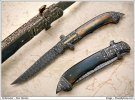Mark Williams
Moderator
- Joined
- Nov 28, 2000
- Messages
- 4,760
I like forging for the freedom I have in moving the metal to whatever shape I want.
I would not even bother trying to make say .. a pipe hawk by stock removal.
And JF is reading this so be nice
I would not even bother trying to make say .. a pipe hawk by stock removal.
And JF is reading this so be nice


